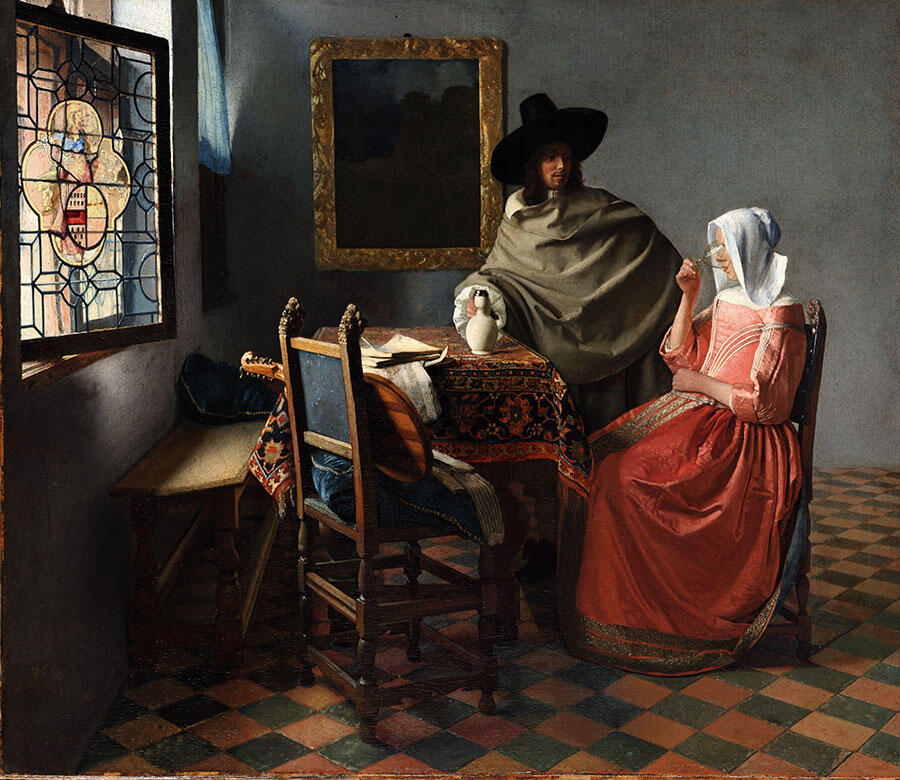How Did Johannes Vermeer Construct His Famous Interiors?
A landmark exhibition at Amsterdam’s Rijksmuseum draws on the latest research to throw new light on the Dutch Master
A landmark exhibition at Amsterdam’s Rijksmuseum draws on the latest research to throw new light on the Dutch Master

The Rijkmuseum’s exhibition of paintings by Johannes Vermeer, opened in early February to great acclaim, is unprecedented in its scope. Of the artist’s modest oeuvre of around 35 known paintings, 28 are on show here, on loan from galleries all over the world. Three from New York’s Frick Collection are on loan for the first time ever during the museum’s temporary closure for renovation. What results is an exhibition not only comprehensive in its scope, but also enlightening and enriching in its use of new biographical research and advanced scanning technologies to subtly shift received notions about Vermeer’s life and work.

Almost all of Vermeer’s surviving works depict interior scenes, his compositions displaying his mastery of light and perspective. Bright daylight streams through stained glass windows, drawing the eye across the image plane, while repoussoir devices – items like drapes or objects of furniture which imply compositional depth – bring the viewer to the heart of the artist’s intimate domestic scenes. His subjects, often house staff or women at leisure, are characteristic of the early bourgeois milieu in which Vermeer lived and worked, while items of clothing and furniture known to have been in his possession appear repeatedly in his work: in five separate paintings, in the case of a yellow satin mantel with fur trim seen in Woman with a Lute (c.1662–64), on loan from the Metropolitan Museum of Art.
Drawing on new research the exhibition supports the theory, proposed in 1964 in the pages of The Art Bulletin by Charles Seymour, that Vermeer was aided in composing his paintings by a camera obscura, a device that allows for the projection of an image through a pinpoint of light. The theory, also advanced by David Hockney in Secret Knowledge (2001), has enjoyed longstanding support in some quarters, but has been controversial in part because no such object was known to be in Vermeer’s possession.

A new biography, Johannes Vermeer: Faith, Light and Reflection (2023), by Gregor J.M. Weber, reopens this question by focusing on religious life in Delft at the time. Vermeer was raised Protestant but converted upon his marriage into a wealthy Catholic family and lived next to a large hidden Jesuit-aligned church. Weber, who is head of the department of fine arts at the Rijksmuseum, argues that light and optics are important themes in Jesuit devotional literature, pointing to a sermon that explores the camera obscura's artistic and moral significance, and identifying a drawing of Saint Apollonia dated c.1650 by a local Jesuit Priest Isaac van der Mye, produced using the camera obscura. Vermeer’s own deeply-held religious faith, Weber argues, is revealed by references in several of his paintings, most obviously in the Allegory of Faith, (c.1670–1674).

Weber goes as far as to speculate that Vermeer could have obtained a camera obscura in 1656, after van der Mye’s death. Its use is perhaps most perceptible in The Lacemaker (1666–68), on loan from the Louvre. The camera obscura casts an image onto a glass plane, allowing the scene to be traced. The technique enables a focal point in the composition to be meticulously detailed, while the foreground and background are blurred, as in human vision. The lace worker’s eyes are trained on the threads, luminously detailed around the middle plane of the image, while a ball of vermillion red and pearly white threads cascade out of focus towards the front. Officer and Laughing Girl (1657–58) displays a similar contrast between the sharp focus of the gold threads in the girl’s dress, and the soft blurring of the officer’s bright red overcoat. Vermeer’s possible use of a camera obscura might also explain why no preparatory sketches or studies are known to have survived, as well as similarities in the composition of many of his paintings.
The Rijksmuseum also challenges established notions that Vermeer painted slowly and precisely. Macro-XRF and RIS scanning technologies have revealed thick lines of black paint rapidly applied underneath the left arm of The Milkmaid (c.1660), indicating that Vermeer began with an underpaint in simple light and dark tones before developing the detail, as painting conservator Anna Krekeler explains on the Rijksmuseum website. The speed of execution reminds us that Vermeer was a busy man: as well as being a painter, he was also a trader of other artists’ work, an innkeeper and a father of 11.

Besides his religious associations, Vermeer was interested in the latest intellectual discoveries, as works like The Geographer (c.1668–1669) remind us. The executor of his estate was his good friend Antonie van Leeuwenhoek, known for his advancements in microscopy. Indeed, Vermeer’s work – nearly forgotten in the 18th century – garnered renewed attention around the popularization of photography a century later. A new Vermeer emerges at the Rijksmuseum. No solemn genius labouring in solitude, but a man of religious devotion, scientific interests and a busy social and working life during a crucial era in the Dutch nation-building project.
‘Vermeer’ is at the Rijksmuseum, Amsterdam, until June 4 2023. Thames & Hudson will release an accompanying book on February 28
Main image: Macro-XRPD scanning of The Milkmaid. Johannes Vermeer, The Milkmaid, 1658–59, oil on canvas, 46 × 41 cm. Courtesy: Rijksmuseum, AmsterdamFoto: Rijksmuseum/Kelly Schenk
























